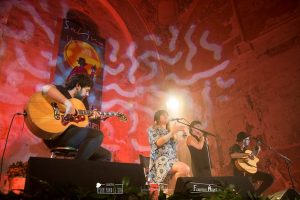by Nicolás Berlanga Martínez
Together with Nicolás Berlanga Martínez, Board Member of the Huerta de San Antonio Foundation, explore the story of the church of San Lorenzo, located in Úbeda, in the south of Spain. It is a wonderful example of a religious building which was saved by the community and transformed to serve a new purpose.
The church of San Lorenzo in Úbeda, a world heritage town in Southern Spain, was in ruin in early 2013. Another hard winter like the one in 2012 would have had a disastrous effect on its walls and roof, probably causing irreparable damage.
The church was first built near a defensive tower of a medieval fortress in the XIII century. In fact, the initial Romanesque chapel ran parallel to the town walls and used the area around the tower as sacristy. A successive enlargement linked both the chapel and the tower with flamboyant Gothic arches, widening the prayer space. A couple of centuries later, the Renaissance boom shaped the space with gentry chapels over burial crypts and a church choir, and squared the big room to host several hundred parishioners. Finally, in the XVIII century a Baroque dome molded the church as it has been known for the last 200 years.

In early 2013, several thousands of people turned to local and religious authorities for a solution to the deterioration of San Lorenzo. The Huerta de san Antonio Foundation grasped this momentum and made the following proposal to the Bishop’s office, who owned San Lorenzo: to fund the urgent restoration jointly in order to save the building; in exchange, the Foundation would continue the rehabilitation and use the space for cultural activities.

Heritage is above all part of common memory. The loss of the church would have erased eight centuries of neighborhood collective memory. The Foundation were initially more interested in recuperating part of that memory than in restoring the church itself. In fact, the Foundation members themselves felt they were part of the social memory at risk, as it was their ancestors who farmed the fields and gardens around the church.
Luckily, the possible disappearance of the church of San Lorenzo feels like a bad dream nowadays. Around fifty activities per year (musical concerts, theatre, traditional markets, expositions, seminars and conferences, etc.) are organised inside the walls that were in ruin only five years ago. This new stimulus is having effects on the neighborhood as well, with houses being restored and younger families coming to live in the vicinity.
There is still a long way to go concerning the restoration of San Lorenzo. However, the pressure is smaller now that it is about internal design, decoration, plaster, details. Furthermore, cultural activities and rehabilitation works can progress together. The Foundation have also discovered that refreshed stone walls offer a wonderful environment to raise awareness about modernity and tolerance, and to foster the importance of education and culture. Such combination of memories from the past and a dynamic present seems to be, in fact, a perfect recipe for the future.








Follow us: